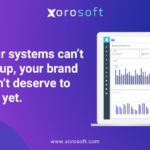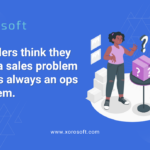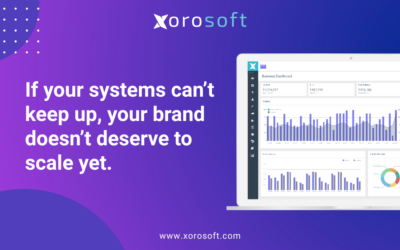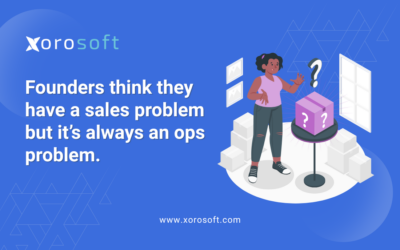
Why eCommerce Operations Automation Is the New Growth Lever
Running a fast-growing brand should feel exciting — not exhausting. However, many founders and COOs spend their days buried in spreadsheets, fixing order sync issues, or explaining stock discrepancies. Therefore, eCommerce operations automation has become essential for leaders who want to scale without chaos. Moreover, it sets the foundation for sustainable growth.
When every order, transaction, and fulfillment task runs automatically, your team finally focuses on expansion instead of firefighting. Ultimately, that’s what Xorosoft ERP delivers — calm, connected, and fully automated operations.
Why Growth Often Feels Like Chaos
As your brand expands, complexity multiplies. Sales grow across Shopify, Amazon, and wholesale; meanwhile, your backend struggles to keep up. Consequently, the success you worked for begins to create inefficiencies that slow everything down. At the same time, customers expect flawless delivery.
Here’s what many fast-scaling teams experience:
-
Orders syncing inconsistently across channels.
-
Manual spreadsheets driving critical inventory decisions.
-
Accounting and operations never fully aligned.
-
Overstock and stockouts appearing within the same month.
-
Little real-time visibility across warehouses or stores.
As a result, growth exposes cracks that manual systems cannot handle. In turn, you accumulate operational debt — the silent drag on every eCommerce brand. Eventually, small issues compound into major slowdowns.
The Cost of Operational Debt
Operational debt grows the longer it’s ignored. Each plugin, spreadsheet, or workaround adds friction to daily tasks. Consequently, you spend more time reconciling than serving customers. In addition, reporting becomes slower and less reliable. Soon, energy that should drive innovation is spent fixing yesterday’s errors.
You’ll know you’ve hit that point when:
-
Reports are built manually and quickly become outdated.
-
Teams re-enter the same order data in multiple tools.
-
Meetings replace insights because data isn’t trustworthy.
-
Decisions depend on guesswork rather than dashboards.
Even though it starts small, operational debt compounds fast. However, automation solves it at the root by connecting every workflow into a single ERP system like Xorosoft ERP. From there, efficiency climbs steadily, and confidence returns.
How eCommerce Operations Automation Restores Control
Automation unites your systems and removes repetitive handoffs. Instead of juggling separate platforms, you gain one synchronized hub for all data and processes. As a result, visibility and control return immediately, and your team executes with confidence. In fact, managers can make faster, better-informed decisions.
| Area | Before Automation | After Xorosoft ERP |
|---|---|---|
| Orders | Entered manually | Auto-synced from all channels |
| Inventory | Updated nightly | Synced instantly |
| Accounting | Managed separately | Linked automatically |
| Fulfillment | Spreadsheet-dependent | Fully tracked in one place |
| Reporting | Manual Excel work | Automated real-time dashboards |
Therefore, when everything connects, every decision becomes faster and more accurate. Moreover, teams stop working reactively and start focusing on growth. In practice, the day feels lighter and far more predictable.
A Real Example of Automation in Action
A lifestyle apparel brand spent six hours a day reconciling orders from Shopify, Amazon, and wholesale. They also faced 12 % late shipments due to data mismatches. Understandably, morale slipped as the workload increased. In response, leadership searched for a single system.
After adopting Xorosoft ERP, they achieved complete eCommerce operations automation in less than four weeks. Orders, inventory, and accounting began syncing automatically. As a result, pick accuracy rose from 91 % to 99.4 %, and order cycle time dropped by 78 %. Additionally, their COO reported saving 25 staff hours every week — time redirected to growth and marketing. Notably, customer satisfaction rose simultaneously.
Seven Steps to eCommerce Operations Automation
1. Define What Freedom Means
Clarify what success looks like before automating. Consequently, your systems align with measurable goals instead of guesswork. Eventually, that clarity pays dividends.
Metric: Hours saved weekly.
2. Centralize All Channel Data
Integrate Shopify, Amazon, and wholesale into one ERP platform. As a result, your operations team works from a single source of truth. Furthermore, errors fall sharply.
Metric: 100 % order sync accuracy.
3. Automate Inventory Updates
Enable live warehouse tracking for instant visibility. Therefore, overselling and dead stock become rare exceptions. Consequently, forecasting becomes far more reliable.
Metric: Zero mismatch between system and shelves.
4. Connect Accounting Automatically
Automation eliminates manual financial updates; moreover, finance and ops finally operate in lockstep. As a bonus, reconciliations close faster.
Metric: Month-end closing 3× faster.
5. Standardize Repetitive Workflows
Consistent processes remove confusion and reduce errors. Consequently, every order and return follows the same smooth path. In turn, accountability improves.
Metric: 100 % workflow compliance.
6. Replace Meetings with Dashboards
Instead of daily check-ins, use real-time KPIs to stay aligned. In addition, you’ll reduce communication fatigue and speed up decisions. As a result, meetings become strategic rather than reactive.
Metric: 50 % fewer team meetings.
7. Optimize Every Month
Automation isn’t static — it evolves with your business. Therefore, review your setup monthly and refine based on new challenges. Ultimately, this habit sustains your competitive edge.
Metric: Continuous improvement in cash cycle time and pick accuracy.
A Seven-Day eCommerce Automation Rollout Plan
Even though automation sounds complex, you can start fast. Here’s a realistic one-week roadmap that Xorosoft clients follow:
-
Day 1–2: Connect Shopify, Amazon, and accounting tools. Meanwhile, confirm integrations are stable.
-
Day 3–4: Automate order imports and inventory sync. Consequently, discrepancies vanish quickly.
-
Day 5: Enable automated invoicing and fulfillment tracking. Additionally, set up alert triggers.
-
Day 6: Build live dashboards for sales and operations. Afterward, share them in a daily summary.
-
Day 7: Train the team and review reports together. Finally, outline improvements for month two.
By the end of week one, you’ll already see measurable time savings. Meanwhile, your team will feel genuine relief from manual tasks.
Answers to Common ERP and Automation Questions
Is ERP too big for small teams?
No — modern tools like Xorosoft ERP scale flexibly. To begin with, automate the area that hurts most; then, expand gradually.
How soon will I see results?
Usually, within 10 days, you’ll notice visible improvements in workflow speed and visibility. By contrast, the old process took months to stabilize. By the first quarter’s end, measurable ROI appears.
Do I need technical expertise?
Not at all. Xorosoft ERP is built for non-technical users; therefore, setup and training remain quick and intuitive.
Does it integrate with QuickBooks or ShipStation?
Yes. Both connect seamlessly for full eCommerce operations automation; in addition, you can keep familiar tools while gaining automation.
Why Automation Becomes Your Freedom Multiplier
Automation doesn’t replace people — it empowers them. Because repetitive work gets handled by systems, your team gains focus and energy. As a result, your brand grows faster and more profitably. Likewise, customers experience better consistency. Ultimately, you build a business that scales without strain.
That’s the true benefit of eCommerce operations automation: freedom to grow without chaos. With Xorosoft ERP, your business finally runs the way you imagined — smoothly, predictably, and profitably.
Automate Your Brand’s Next Chapter
Experience the power of Xorosoft ERP — the platform that unifies operations, accounting, and fulfillment into one automated system. Therefore, you can finally focus on customers instead of coordination.
Start your journey toward complete eCommerce operations automation today — and make operations truly effortless.









